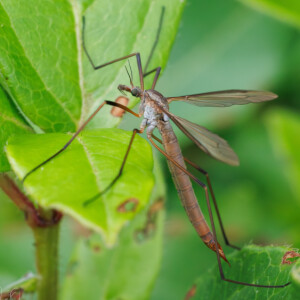Final instar
Not long to go now: this fifth instar Green Shieldbug nymph only has to moult once more to achieve adulthood. That said, it will be a pretty significant transformation from this stage to the adult, which will be shield-shaped and fully winged. It's fascinating to me to think that this adult form is in the process of developing right now, beneath the nymph's cuticle, and it's only when the adult bug is fully developed that the nymphal skin will split to allow it to emerge.
I've never seen a newly eclosed Green Shieldbug, and I doubt I will this time either - the nymph is pretty good at hiding itself in the honeysuckle, and it will doubtless choose to moult in private if it can. But last summer we had a couple of final instar Red-legged Shieldbug nymphs on one of our apple trees, and this image shows one of them alongside the companion that had recently undergone its final moult. The size difference is quite dramatic, though not having been present at the "birth" I don't know if the adult emerged like the Incredible Hulk, swelling as it came, or if there was a lengthy inflation period afterwards, as happens with Odonata. The second nymph moulted the following day and I contrived to miss that emergence as well, but this shows the bug shortly afterwards, full-sized but still teneral - that is, pale and soft-bodied. The chitin-based cuticle of a shieldbug develops colour as it hardens.
My second photo today carries a trigger warning for people who are repulsed by craneflies. R said to me the other day, "What is the point of craneflies?", and without missing a beat I replied, "Food." Then, before he could react with disgust, "Everything eats them. Spiders, birds, dragons..." "Oh, OK," he said. "That's fine then." Later I looked them up, to check that I hadn't said something daft, and found that the Natural History Museum broadly agrees with me - though I'd neglected to say that craneflies are also important food for bats, of which we have a good number here.
While not claiming expertise (in anything), I think this specimen is most probably Tipula paludosa, the Common Cranefly. Despite its name, this isn't necessarily our most common species: according to Naturespot, at least, that might be Tipula oleracea, the Marsh Cranefly. But that's primarily a spring species, while T. paludosa is more often seen in autumn, and if she were a Marsh Cranefly this female's wings would have been as long as her abdomen, which they weren't.
R: C5, D7.


Comments
Sign in or get an account to comment.


